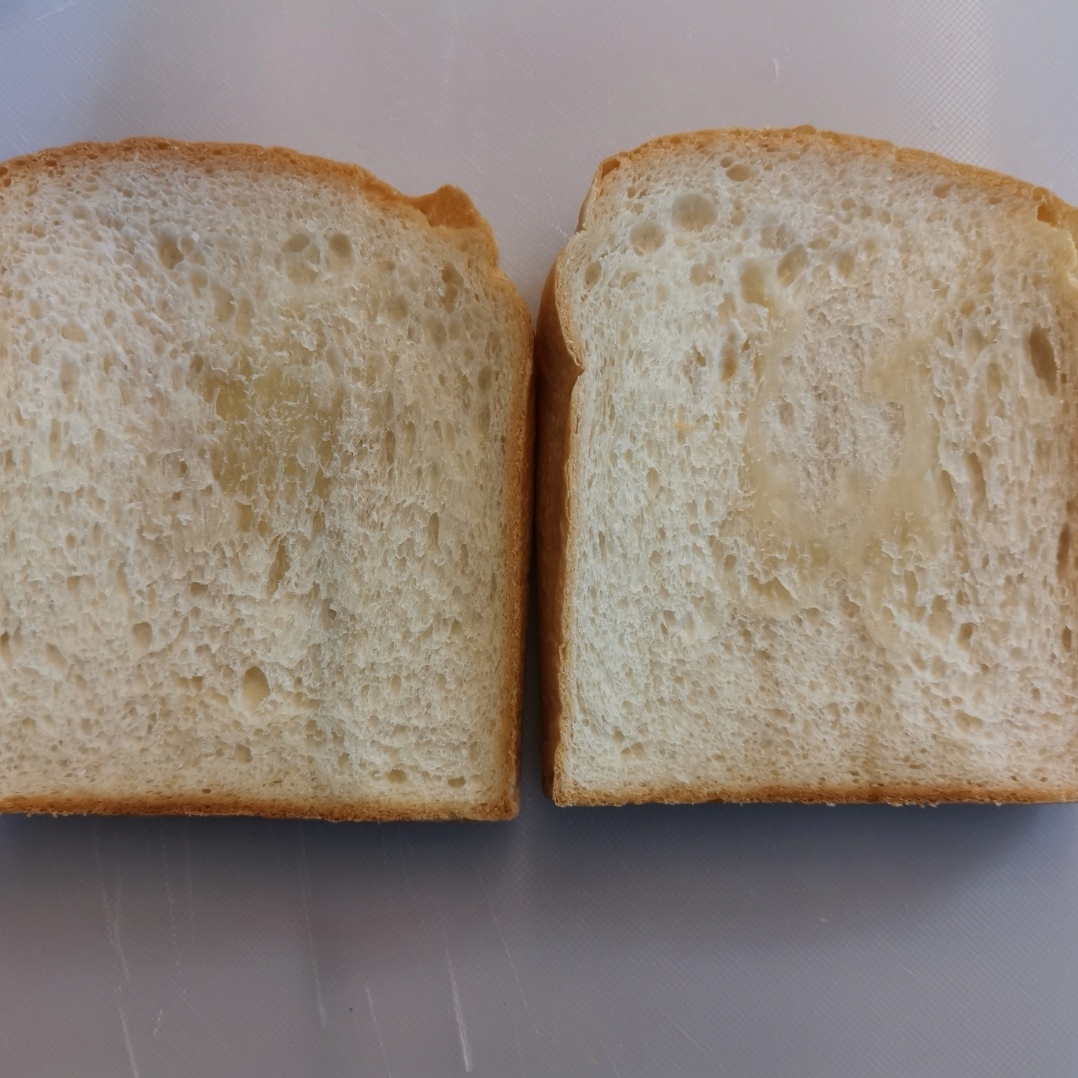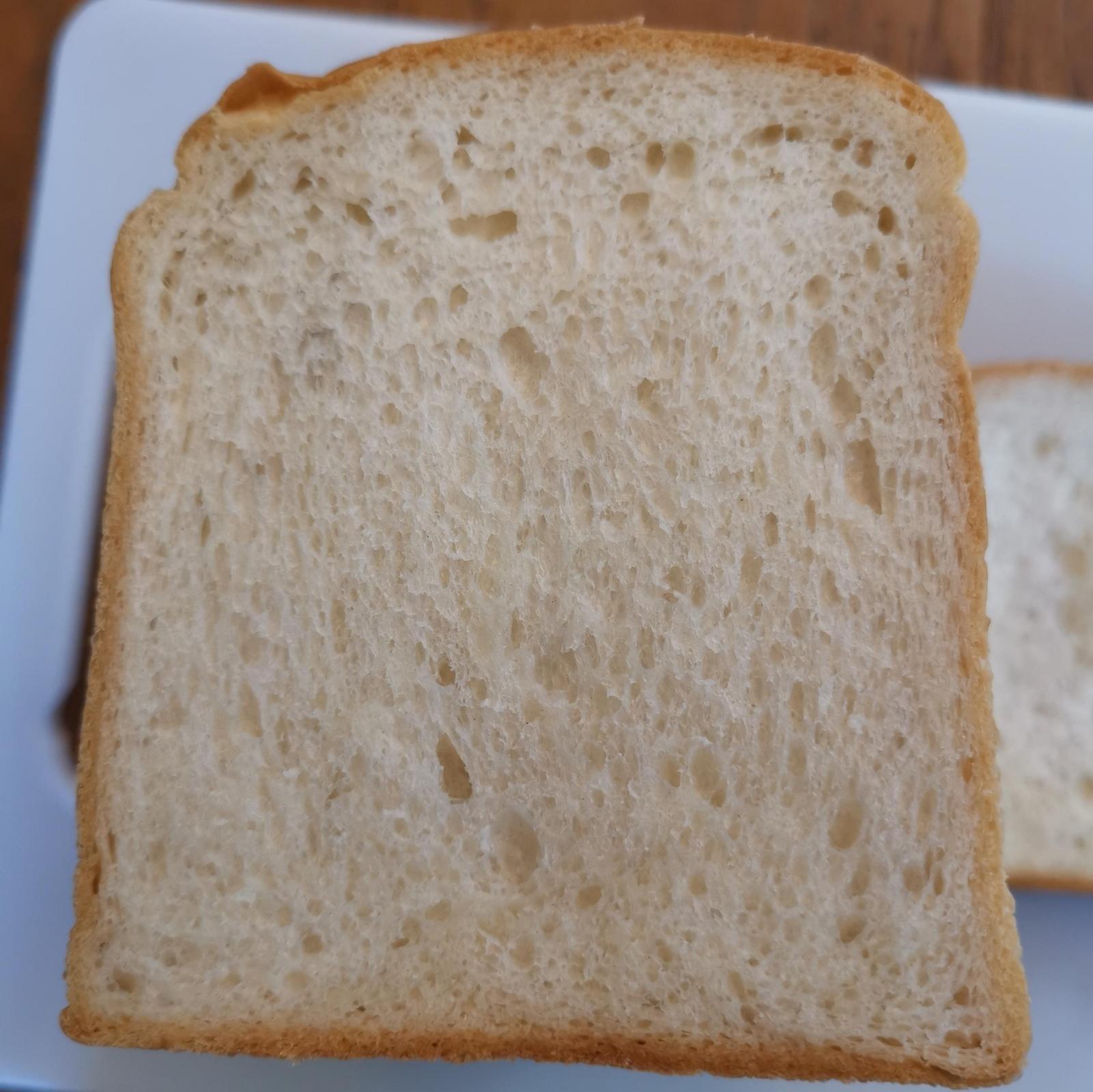Hey everyone! New to The Fresh Loaf.
I've been baking milk loaves and am quite happy with the results except for 1 issue. Both ends of the loaf always get this doughy/gummy mass as seen in the photo below. Only the edges (about 1/4 inch thick) are like this, while the rest of the loaf looks fine. It happens to me every single bake, despite adjusting baking time and temperature.
Photo of loaf ends:

Photo of middle of loaf:

My recipe uses bread flour, 73% hydration (milk + cream + water), and includes a Yudane starter (1:1 flour and boiling water). It is leavened by instant dry yeast at 1%. The dough is sweetened with honey and enriched with butter. The total weight of the dough is 600g after mixing until thin windowpane.
Bulk fermentation happens for about an hour before it is shaped and rolled into 3 logs. The 2nd proofing is about the same or until the shaped dough reaches half an inch below the tin.
I bake the loaf in a 450g dark aluminum alloy loaf pan (brand is called Sanneng from Taiwan) in a preheated 180 C gas deck oven for 40 mins, bottom heat only. The loaf is rotated 90 deg halfway thru the bake. The loaf is de-panned immediately after taking it out of the oven and cooled on a rack for at least 2 hours before slicing. The loaf in the photo was sliced 4 hours after baking.
Thoughts about what could be causing this? Any feedback would be appreciated!
Thank you.
and....how are they placed into the oven? Like this: | | Or like this: / / ?
of the outside but will do it tomorrow when I bake again. From the outside, you can see the ends sucked in a little bit.
I place the loaf pan in the oven like this: | and rotate it midway through the bake to this: -
My guess is your pan has handles at the ends that are preventing heat-transfer either during final proof in the pan, and/or during baking.
or....
During final proof, you are placing the pan in or near some objects that are cooling the ends.
Or... in the oven, there are some objects/things at both ends interfering with air flow or heat transfer to those two spots.
Or... some combination of the two: handles at the ends of the pan, and some odd physical arrangement during proof or bake.
about the ends cooling during the final proof. I haven't really thought about this. Will observe and take notes next time!
I did not pick up on the fact that you are baking 3 loaves at once.
If the pans are placed end-to-end in the oven, and the outer ends are too close to the wall, that could cause your symptom.
Questions:
When you bake 2 or 3 loaves at once, does this happen on both ends of all the loaves?
When you bake only one loaf, does this happen?
When I bake more than 1, the same thing happens. You might be right about the symptom being caused by something in the pan as it doesn't happen with my other baked goods baked in aluminum pans or trays. I like this loaf pan for the non-stick properties but might be good to try other pans as well.
Attached is a photo of the current pan I'm using:
Do you have the shiny "san neng" logo on your pans and lids? Does the location of the logo correspond to the undercooked areas on the loaves? Check top of loaves as well. If so, can you carefully remove it or paint it black with a permanent marker? The logo could be reflecting just enugh heat to be bothersome.
Another solution might simply be to slightly lower the baking temp and extend the baking time to keep crust light in color.
And another solution might be to not line up the pans so squarely, more diagonally so more heat can circulate around the ends of the pans.
We have a winner. It's the logo on each end.
I vote for covering with permanent marker. Scraping off the paint/ink might remove the dark coating underneath, resulting in the same phenomenon.
loaves are proofiing anywhere near a blowing airconditioner cooling the ends of the loaves during the rise. That might make a more obvious effect.
I found flour delivered in plastic packaging very thirsty so 72% hydration may sound high at first but it is not. Not at first. With the flour exposed to the ambient high humidity, less hydration is needed. Have you thought about reducing the hydration a few percentage points if the flour is stored openly during work hours?
As it turns out, when I decreased the water content by 10g bringing down the hydration to 70%, the doughy mass was partially gone. The loaf was still as soft and moist as I want it to be. I can probably reduce the liquid by another 10g or add 5 more minutes of baking time and I think that should get rid of it completely. My flour is stored in a cloth bag and in my kitchen with high humidity. So I think you are definitely right about this one.
Your comments were truly helpful! Appreciate it. Thank you!
I will also be covering the sanneng logo with a black permanent marker!
help out.
Maybe you should try cooking the last 10/15 min without the loaf pans
My only challenge would be keeping the loaf from browning too much but better than having doughy or gummy parts!
Have you tried taking it out of the pan and baking it for another 5-10 mins after you usually end the bake? This can help dry the loaf a bit more.
Benny
Will definitely try this one out too.